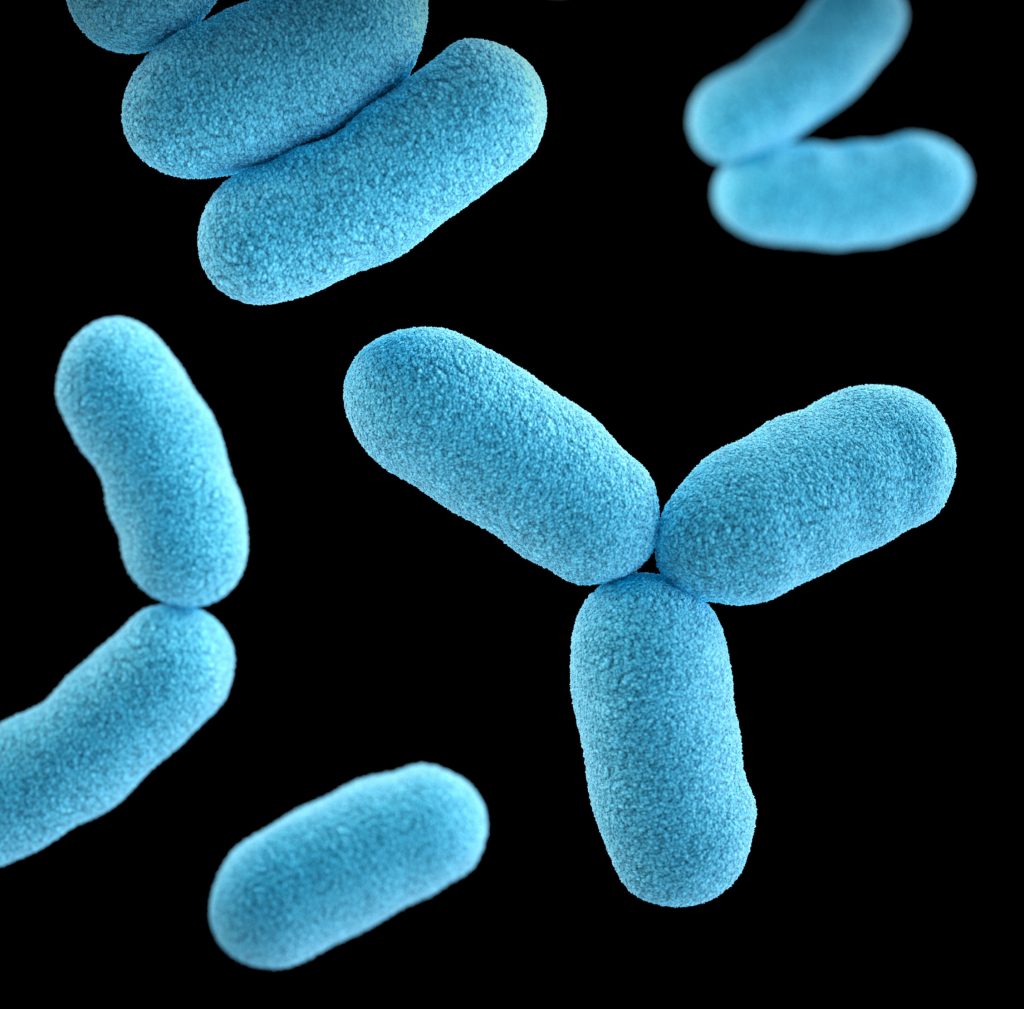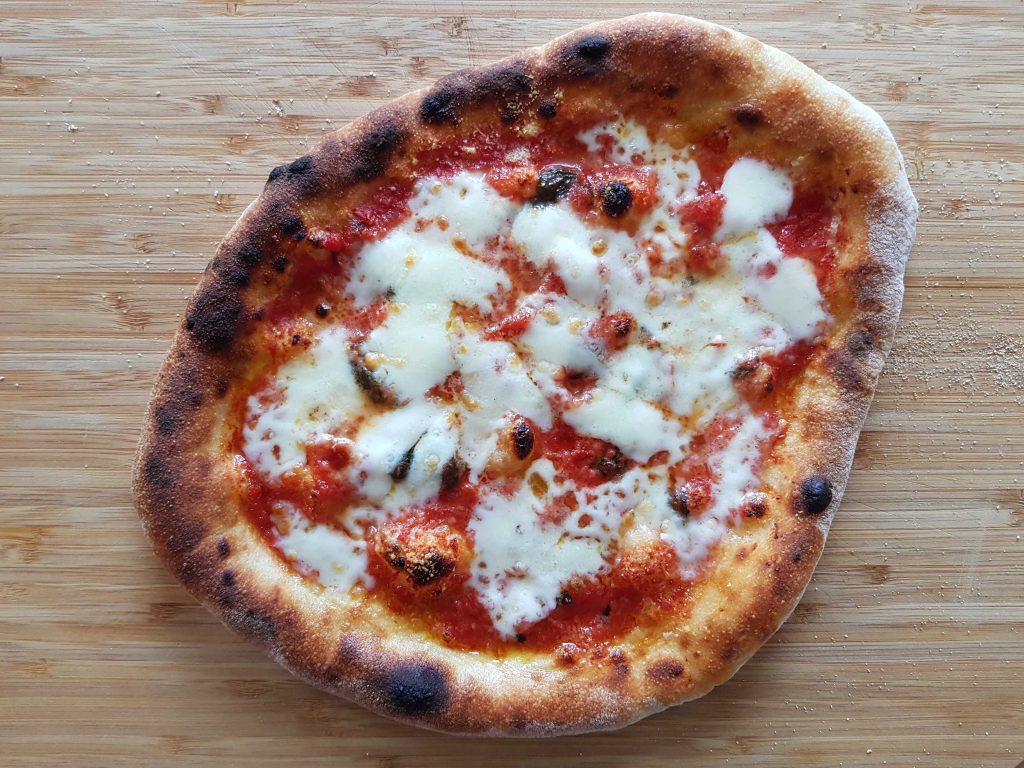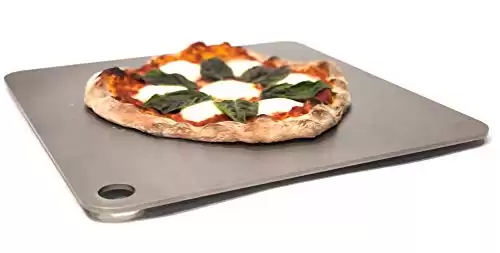Eating undercooked pizza dough can be unpleasant, but did you know it might even be dangerous?
Is it safe to eat undercooked pizza dough?
I’ve heard several people complain about stomach aches after eating undercooked pizza, so it got me thinking. Is it really safe to eat undercooked pizza? Can it even be dangerous? After doing some research, here’s what I found.

According to the CDC (Centers for Disease Control and Prevention), “Raw dough can contain bacteria that cause diseases”. The reason is that flour is usually not treated to kill germs and bacteria. It can, therefore, contain bacteria, such as E. coli, which cause food poisoning.
Raw dough can contain bacteria that cause diseases.
– Centers for Disease Control and Prevention
I wasn’t able to find any research looking into pizza dough specifically, but according to the USDA (United States Department of Agriculture Food Safety and Inspection Service), the “danger zone” for bacterial growth is between 40-140°F. You, therefore, want to bake your pizza to an internal temperature of over 140°F, to make sure it’s safe to eat.
It’s therefore not safe to eat raw pizza dough, as it can contain bacterias that can cause disease. But in addition to not being safe, it’s also not very pleasant to eat raw pizza.
I haven’t personally heard any stories about anyone getting sick from undercooked pizza. The reason is probably that even if the pizza is undercooked, it’s rarely, if ever(?), served raw. But I’ve heard about several people getting a stomach ache after eating undercooked pizza, so it’s better to avoid it and rather be safe than sorry. You should always take food safety seriously!
Why your pizza dough is undercooked
The most common reasons for undercooked pizza dough are:
- too low baking temperature
- too short baking time
- the pizza crust is too thick
- overtopping of the pizza.
Luckily all of these things are easy to fix!
Baking temperature and baking time are closely related. The higher the temperature the shorter the biking time. Likewise, a shorter baking time requires a higher temperature to achieve the same results.
To get a great pizza, you should aim for a quick bake in a hot oven. That’s how you get a crispy pizza crust that’s still soft and light in the middle, just like in an Italian restaurant.
Too low baking temperature
To understand how the temperature affects the final result, you need to understand pizza baking first. In a wood-fired
Therefore, if you want to bake pizza at home, you need to replicate the baking environment. You need a radiating heat source above the pizza and a hot baking surface that the pizza is in direct contact with.
Bake the top of the pizza using the broiler method
Let’s address the radiating heat first. You might think: “I don’t have a fancy wood-fired
Most home ovens come with a broiler, located in the ceiling of the oven. The broiler gets really hot and is perfect for fast pizza baking. You can even get that charred leopard pattern that you often see in Italian restaurants.
The radiating heat from the broiler can’t reach very far. You, therefore, want to place the pizza as close to the broiler as possible without touching it, obviously. Ideally, you want the pizza to be around 1-2 inches from the broiler. This will make a really awesome crust on your pizza!
Fast baking of the top of the pizza is also great for the cheese and other toppings. The reason is that a lot of moisture from the toppings, cheese, and sauce will vaporize during baking. Using the broiler is the key to achieving an awesome bake at home.
If you want to perfect your pizza baking at home, check out my guide here.
A hot baking surface is essential for baking the bottom of the pizza
The second part of the equation is the baking surface.
Baking your pizza on a baking sheet, simply won’t do the trick. It’s simply not getting hot enough. When you put the cold baking sheet in the oven, it needs time to heat up, before it reaches a temperature where it bakes the bottom of the pizza. Baking sheets are also pretty thin and are often made from aluminum. They, therefore, don’t retain heat very well. Baking sheets are therefore not ideal for pizza baking, and it’s easy to end up with an undercooked pizza.
There is, however, a simple solution to this problem! The secret is to bake pizza on a pizza stone or pizza steel. Both are designed to work as a baking surface for home ovens. They work by retaining and conducting heat that helps bake the pizza faster. They will hold a lot more heat, and transfer it to the pizza dough than a baking sheet. And the result on a pizza stone or steel is fairly similar to a wood-fired oven!
One important thing worth mentioning is that you need to preheat the baking surface before baking pizza on it. Usually for 45-60 minutes.
If you don’t already own a pizza stone or
A pizza stone is typically a bit cheaper. But personally, I prefer pizza steels. That’s what I bake most of my pizzas on. The main advantages of pizza steels over stones are that they are more durable, conduct heat a bit better, and are easier to clean and maintain.
If you combine the use of a pizza stone or

Too short baking time
If you don’t have a wood-fired oven, you need to bake your pizza longer.
In general, when you bake pizza, you want to increase the temperature to reduce the baking time, rather than increasing time. The goal is to get a crispy, charred crust, and if you can do this in a shorter period of time, you’re going to end up with a pizza crust that’s crispy on the outside, but still nice and soft on the inside. This can only be achieved in a hot oven with a short baking time. You, therefore, aim to reduce the baking time but increase the heat. But you still want to bake the pizza long enough to be crispy and nice on the outside.
Overtopping the pizza
Another reason your pizza is undercooked can be overtopping. This can be too much sauce, cheese, or any other toppings. Pizza gets crispy in the oven by evaporating moisture. The pizza can’t get crispy if it contains too much water. The more moisture the pizza contains, the harder it’s going to be to evaporate enough water to bake the dough properly. Therefore, be cautious when you add toppings to your pizza.
More is less when it comes to pizza toppings!
The dough is too thick
The last reason is too thick pizza dough. It’s going to take longer to bake a thick pizza because the heat takes longer to penetrate the dough and bake the center of the pizza. Therefore, a thick dough is going to take longer to bake than a thinner dough.
This is part of the reason why Neapolitan pizza is so thin. It can be baked quickly in the oven. You can’t really bake thick pizza in a wood-fired oven because the outside of the pizza will be completely burnt before the center is fully cooked. If you want to recreate Neapolitan-style pizza at home, you, therefore, need to make thin pizza, using Neapolitan pizza dough.
How to dix undercooked pizza dough
1. Make thinner pizzas
The first thing you need to do to prevent undercooked pizza dough is to make sure you make a thin pizza. I recommend using Neapolitan pizza dough. This recipe is great. With a proper dough, it’s easy to stretch it super thin. I promise it’s going to be the crispiest pizza you’ve ever tried. And there is no way you’ll undercook this dough!
2. Don’t overtop the pizza
You also want to make sure you don’t use too much sauce, too much cheese, or add too many other toppings. This will add moisture to the pizza, which is going to increase the baking time.
3. Bake the pizza in a blazing hot oven
Make sure the oven is hot enough. And that you use a pizza stone or
Also, make sure to bake the top of the pizza. I recommend using the broiler. You can also turn on the broiler while preheating the pizza stone or steel. This will make the baking surface even hotter!
I also recommend turning the broiler off and slightly lowering the heat of the oven a few minutes prior to baking. The reason is to make sure the broiler is on when you bake the pizza. The broiler usually turns off when the oven is at the highest setting because it doesn’t want the oven to get any hotter. So with this trick, you can actually bake the pizza at an even higher temperature!
By using these methods, you will never get an undercooked pizza again!
- Gi.Metal Turning Peel Review: Is This the Ultimate Pizza Tool? - April 14, 2024
- Discover Pizza Mastunicola: The Story of the First Pizza - April 7, 2024
- The Ultimate Buyer’s Guide to the Best Pizza Peel of 2024 - April 4, 2024

I can tell you that I did make several friends ill, serving undercooked Pizza. It was very embarrassing and my wife would not let me invite any friends over until I got the pizza making down to a science. I made several mistakes. I always thought that if I had too high of a temperature in the oven the outside would cook too fast leaving the inside doughy. Not quite.
I spent a while perfecting the crust too. https://www.beachstreetnews.com/easy-guide-to-sourdough/ has the recipe and a quick guide for free.
It turned out I was making several mistakes and you nailed them.
1. Dough too thick, If you want thick crust like Chicago it needs to be in a metal pan.
2. Too much sauce.
3. Not letting the pizza oven get hot enough to insure the bricks on the bottom were up to temperature.
and of course
4. Not cooking long enough. I was trying to make a perfect light brown crust and cheese like a big chain pizza, instead of the perfect pizzaiolo pizza with a few black dots.
Thanks for confirming my findings.
Scott
Hi!
Hi👋
On November 17th 2021 I ordered Italian cheese bread from little Caesars pizza and all 3 orders were raw we could have been food poisoned! The heck I’m gonna take this sitting down!!